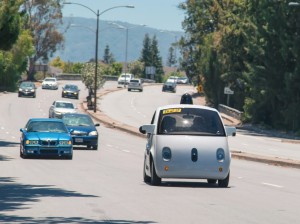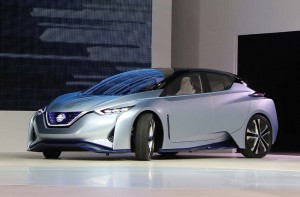
A Google car in traffic. A new study suggests autonomous vehicles are experiencing five times the rate of accidents as regular cars.
Proponents have promised a world in which crashes, injuries and fatalities are virtually absent, but a new study warns that, at least for now, autonomous vehicles aren’t coming close to meeting those expectations.
The limited number of test vehicles now on the road have been involved in crashes at five times the rate of conventional vehicles, according to an analysis by the University of Michigan’s Transportations Research Institute, or UMTRI. But the news wasn’t entirely bad.
“Self-driving vehicles were not at fault in any crashes they were involved in,” wrote researchers Brandon Schoettle and Michael Sivak. And, they added, “the overall severity of crash-related injuries
involving self-driving vehicles has been lower than for conventional vehicles.
Autonomous vehicle technology is rapidly moving from the realm of science fiction to the real world. Tesla Motors has now released a software update for its Model S sedan, dubbed AutoPilot, that allows a vehicle to operate hands-free on well-market, limited-access freeways. Cadillac, Mercedes-Benz, Nissan and several other makers plan to launch similar systems over the next few years.
Nissan intends to go even further, promising to put into production by 2020a fully autonomous vehicle, able to handle even complicated urban roads. It previewed what that might look like during a news conference last week marking the opening of the Tokyo Motor Show.
(Tokyo Motor Show puts emphasis on green, autonomous vehicles. Click Here for the story.)

The Nissan IDS concept vehicle features two modes: one simple assists the driver, the other mode takes complete control.
The IDS – short Intelligent Driving System – prototype would be able to “compensate for human error which causes more than 90% of accidents,” said Nissan CEO Carlos Ghosn.
The problem appears to be that, at least for now, humans and autonomous vehicles may not mix.
So far, the vast majority of accidents involving self-driving vehicles have been reported by Google, the tech giant already clocking hundreds of thousands of miles of testing in conventional vehicles converted for autonomous use, and now rolling out a fleet of specially designed self-driving “Google cars.” But a number of other manufacturers are now testing the technology on public roads – even truckmaker Freightliner.
For the purposes of the study, UMTRI researchers looked at 11 crashes involving self-driving cars – a figure that’s now gone higher. But that’s among a relatively miniscule fleet that have, according to the study, clocked barely 1.2 million miles, all told.
When you work out the numbers, UMTRI determined the autonomous vehicles were five times as likely to be involved in a crash as conventional vehicles. But they added a number of significant caveats. For one, thing: the number of accidents involving human drivers is probably quite a bit higher than what police reports would indicate. So, the real ratio is likely a good bit narrower.
(Click Here to check out the Nissan IDS autonomous prototype.)
Injuries in those autonomous vehicle crashes have almost all been minor, so far, noted Schoettle and Sivak, in part because the self-driving cars are often being tested at lower speeds.
And, perhaps most importantly, every one of the accidents reported appears to have been the result of human error. But that doesn’t mean the autonomous vehicles are entirely without fault. Several other reports have warned that self-driving cars won’t operate in a vacuum. For decades to come, they’ll have to share the road with human drivers.
That’s something engineers have to keep in mind when, for example, they program an autonomous vehicle to stop at the first sign of a yellow light. Considering how often humans try to beat the red, that’s a formula that could cause problems, as police reports for a number of the Google crashes have indicated.
“That is something we are working on,” said Tetsuya Ijima, the chief engineer on Nissan’s autonomous vehicle program.
The company has not only hired software engineers to program its vehicles but even has an anthropologist on its team to try to understand the way humans actually drive, a critical factor that must be better understood before fully autonomous vehicle technology reach market early in the coming decade.
(Click Here for a test drive of a fully autonomous Nissan Leaf prototype.)

Previously, I have been completely against self-driving cars. I like to maintain 1 car length per 10 mph on the freeway for safety. Usually my safety space seems big enough for two other cars to fit in, and they usually do that.
Since 1969, number of cars in California has tripled while the freeway lanes have not. The stifling congestion is really getting to me.
Bay Area/ Sacramento / I-80 corridor. Nowadays always clogged. A self-driving car where I could just relax is beginning to make sense.
It’s not that most humans are trying to beat red lights that caused the Google accidents, though some folks do. It’s that the Google vehicles are slamming on the brakes as soon as the traffic light turns yellow, when the software needs to be able to tell if a panic stop is appropriate or if the AV should pass thru the intersection on the yellow light as was the original intent of yellow “caution” lights. The yellow light is to allow time for the intersection to clear before the cars on the side streets are allowed to proceed. These accidents were clearly not human driver errors but programming errors.
AVs will need to be able to determine how far they are from the traffic light, what a reasonable stopping rate is and determine the appropriate stopping distance based on vehicle speed and proximity to the traffic light. Google also has programming issues with pedestrians on bicycles causing the Google cars to stop at intersections and refuse to move when a person on a bicycle is next to a Google car.
Slamming the brakes on in MI causing the car behind to hit the car in front means the car in front is held 50% responsible for the accident.
Two out of three accidents involving automobiles and semitrucks is the fault of the automobile drivers. A professional truck driver is evalutated and tested to a higher degree. The same should be for automobile drivers unless they establish a safety record or maybe have to let the car drive it self instead of them:-).